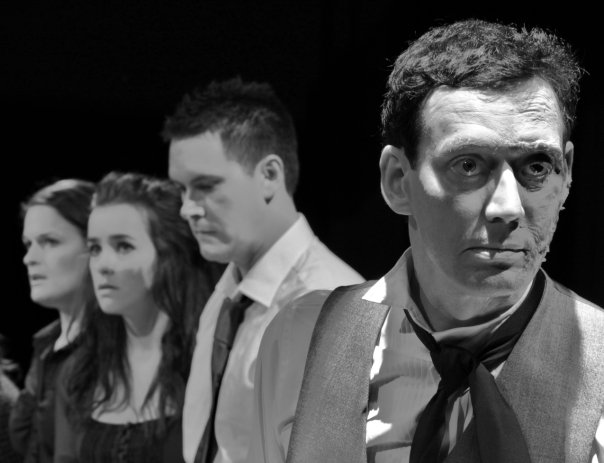The plot: six characters, one lift, and a mutual party. Mix these ingredients with the 70-minute-play’s single set and you’ll think, “well, what now?”
Arriving at Lincoln’s Drill Hall to watch Darren A. Furniss’ Going Down, I was confronted with what looked like undead bell-boys. Milling around the foyer, the extras stood perfectly still, except for the whimsical wide-eyed head-turn and a shifting of their weight, now and again. Was this a horror play? It certainly looked as if it would shock.
When entering the hall itself, the bell-boys dispersed, somewhere, until one was left. A man, half dressed in what looked like formal evening wear. But it was scruffy on one side. His trousers were torn and blood-stained, his attire mismatched, and half of his face hanging off.
Not the classic lift operator in appearance, but perhaps in duty. Playing a minimal role, he continued to operate the lift so that more and more of the characters were introduced as the floors passed. He says nothing to the people who get into the lift. Even if the odd one is panic-stricken and needs to confide in someone, he will only announce floors and say “going down”.
Common ground is something the characters seek out throughout the the play, but for the worse. The writer has an annoying habit of scripting the occasional jolt in the lift mechanism, knocking the characters’ confidences. Cue the bemused/”breathe-through-your-mouth” scared faces. Cringeworthy.

Monologues followed group conversation. The set’s lighting would fade and a spot would appear for the individual to stand and deliver. Some were very good, but none were believable. The writer had constructed a predictable formula:
1. Cocky head turns. 2. Over-zealous volume changes. 3. Screaming after complete silence. 4. Stuttering and long pauses, brought on by all issues.
Could this be a new concept? “Digital drama”, where intensity is either on or off, with no nuance.
The ScotsGay review 2008 promised a “Passionate, powerful, and gripping” play. However the real outlook, while bouncing around these dramatic parameters, was “Stiff, repetitive and lewd”. The structure was rigid to the point that, as an audience member, I felt slightly embarrassed for the next protagonist who had to step up and deliver their monotonous monologue. But was this due to the writing? Each character clearly had “issues”, so to speak, and why wouldn’t they? The writer showed the characters in a try-hard light, too projective and not overly self-aware, as a group. Nothing in the plot unrolled or was given the chance to stew. Predictable.
The overall message was unclear too. The characters would be whittled out of the play by the half-undead lift attendant, telling them they had arrived at their floor. But why at that time? Where did they even get off? The fact that the intrinsic banter went on when the lift was in motion, posed the question as to how high was this building for the lift to be in motion for 70 minutes?
Before it was even half-way through, the writer managed to successfully turn shocking disbelief into complete desensitised hysteria. The writer comically layers up every single criminal archetype: a rapist, a murderer, a porn star, a pedophile, an adulterous beast, and a power-dressing megalomaniac, in just six characters. I was honestly starting to think that the writer was working quantifiably: “12 pounds for 12 criminal archetypes.”
The play itself was inconclusive and abrupt in ending, leaving the audience not wanting to know more, but confused as to what the plot was. Looking very closely between the lines, the play itself fails to offer a gripping story, but does manage to raise some thought-provoking issues. The audience can relate, once they look past the stiff and awkward acting, and most importantly the clichéd and predictable monologues. The characters were not sensationalised, and could have been any one of us sat in the audience. As far as that goes, it was relatable. But because the acting was flat and brash, on any and all levels, it didn’t leave anything to the imagination, which should have been this play’s most powerful tool.
— Katy Shinton contributed to this review.
